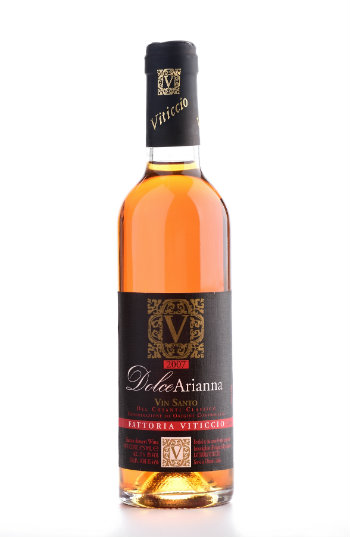A favorite after-dinner dessert or fireside accompaniment to relax during the evening is, for many Tuscans, a glass of sweet Vin Santo alongside a plate of crunchy almond cantucci for dipping. But what is it about Vin Santo that makes it so special?
Vin Santo: Holy Wine
Vin Santo is a sweet wine traditionally made in Tuscany by pressing dried grapes and fermenting the concentrated juices. It is beloved for its rich, golden hue and notes of caramel, honey, dried apricot, hazelnut, and tropical fruit, and comes served in a small glass (or sometimes in a bowl for easier biscotti-dipping). Swirl the Vin Santo in your glass and notice how the legs, or the wine that drips slowly down the sides of the glass, are viscous and thick: this is because the alcohol and sugar content are high. For Vin Santo del Chianti Classico DOC, for example, this means a minimum of 16% alcohol and 27% residual sugar.
Vin Santo is served with crunchy, almond-studded Tuscan cookies called cantucci or cantuccini—those long, hard cookies that non-Italians call “biscotti.” The word, in fact, means “twice-baked,” and it is indeed for this reason that the cantucci are so hard—and therefore perfect for softening in your Vin Santo! But today, the term “biscotti” is used to denote any cookie in Italy.

Cantuccini – by photolinda, CC
Speaking of names, why “Vin Santo?” For a wine whose production is documented as far back as 800 BC, there are sure to be several background stories to its origins. At first glance, Vin Santo means “holy wine,” perhaps because it was often used in Mass or during Easter Sunday—right around the time that some producers begin fermenting their Vin Santo. But another theory states that the wine was named for its ancient Greek cousin, Vinsanto, whose own names comes from “vino Santorini.” With such an ancient lineage, it’s hard to pinpoint the true origins of its name, but most seem to favor the holy wine theory.
How to make a holy wine
While every region in Italy makes a version of sweet wine, and many are extremely good and each have their own, unique characteristics, Vin Santo’s DOC home is in Tuscany. Here, over a dozen DOCs exist for Vin Santo, but the three most important are Vin Santo del Chianti, Vin Santo del Chianti Classico, and Vin Santo del Montepulciano.
Viticcio’s sweet gem is called Dolce Arianna Vin Santo del Chianti Classico DOC. It’s made with the grapes malvasia, trebbiano, and cannaiolo, classic native varieties of Tuscany. Malvasia and trebbiano, two white varieties, were actually once used in Chianti Classico blends up until 2006, before it was decreed that the wine could no longer be made using white grape varieties. This led some producers to uproot their white vines to replant with sangiovese, but many other wineries seized this opportunity to repurpose their white varieties into producing the delicious and ever-popular Vin Santo.
After harvest, the grapes are brought to a well-ventilated and protected room where they’re left to dry for months at a time—ether hanging or laid out on wooden racks. At Viticcio, we harvest the grapes before they overripen in order to retain acidity, which helps balance out the sweetness of the final product. We then dry our grapes for three months—again, this helps retain an acidity-to-sugar equilibrium, for the longer the grapes are dried, the more concentrated their sugars become—before gently pressing them and fermenting for six years in oak barrels of 70 l.
This is where the production of Vin Santo can get tricky, for at the bottom of the small barrels is a residue called the madre, or the fermentation yeasts left over from the last batch of Vin Santo. This is what starts the fermentation process and, if it’s an efficient strain of yeasts, will help the wine stabilize during temperature fluctuations and keep it fermenting for many years.
By the end, we have an exquisite product that is so delicious, you’ll want to savor every drop in the crumbs of your cantucci for as long as possible.





